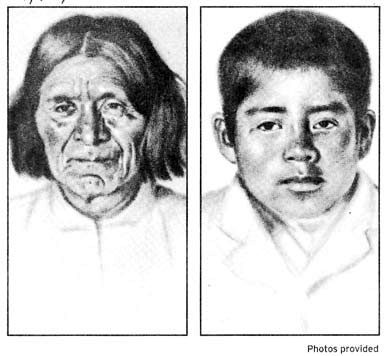
Elbridge Ayer Burbank painted American Indians, young and old.
These are from tribes in Arizona or New Mexico.
Among the 68 paintings on display today through July 13 at Chicago's Newberry Library, are these two.

Elbridge Ayer Burbank painted American Indians, young and old.
These are from tribes in Arizona or New Mexico.
Among the 68 paintings on display today through July 13 at Chicago's Newberry Library, are these two.
Posterity discovers poor Harvard artist
Jerry Kuyper
April 13, 2002
Northwest Herald, used with permission
HARVARD - A native son is being honored in Chicago this year.
Today through July 13, the Newberry Library, at 60 W Walton
St., will display 68 oil paintings by Elbridge Ayer Burbank.
A library publicist called it the first significant exhibition of Burbank's work since the early 20th century.
Grandson of an early McHenry County settler, Elbridge Gerry Ayer, Burbank was born in 1858, left his native village in 1874 to study at Chicago's Academy of Design (today's Art Institute) and opened a small studio in St. Paul, Minn., in 1880.
Before moving back to Illinois and opening another studio in Chicago, Burbank traveled to Munich, Germany, for a year of study. He was in Chicago for the 1893 World Columbian Exposition and seemed to be enjoying a modicum of success in the art world. His work was displayed in art organization exhibitions, and he also served on several art jury panels.
His life changed forever when his maternal uncle, Edward E. Ayer, first president of the Field Museum of Natural History and a trustee of Newberry Library, asked Burbank to go west and paint Geronimo, one of the most famous of the Apache chiefs.
He arrived at Fort Sill in March 1897 to paint the portrait of this most famous of the Apache chieftains who, Burbank thought, was behind the fort's prison bars.
"Having heard of Geronimo only through the screaming newspaper headlines, which exploited his daring raids and cruel massacres, I was prepared to meet a thoroughly bloodthirsty savage," Burbank wrote in later years.
"I gave thanks that I did not have to encounter this crafty Apache at large, but instead could sketch him behind prison bars. Imagine my great surprise upon arriving at Fort Sill to find that Geronimo was not in prison at all but was allowed his freedom. He lived in a house the government had built for him, a one-story affair built around a patio."
Burbank walked to the house, but the chief was out riding his horse. Burbank sat down on a front step and waited. The wait was short.
Burbank got off on good footing with Geronimo by calling him chief, and not a nickname. The soldiers had nicknamed this short, muscular chief "Gerry," and this did not go over well with this wizened guerrilla warrior of the American Southwest.
Burbank also offered the chief a cigarette, which the chief accepted. The two men, one a 30ish white artist from Chicago and the other a fierce warrior of the desert, puffed silently while they considered each other.
"All this time Geronimo was peering at my face," Burbank said. The chief warmed to Burbank and, eventually, over the weeks that followed, allowed a portrait to be done. Burbank never returned to polite society, in spirit, again. He wrote his uncle, "I have never been so taken with a subject as I am with these Indians. I have made arrangements to stay here all summer."
He vowed, as his life's commission, to paint every Indian tribe in America. He failed in that, but he did his best to record on canvas or paper quite a few tribes, including Apache, Navajo, Hopi, Cheyenne, Sioux, Kiowa and Nez Perce.
"The rest of my life will be devoted among the Indians, and I have a life's work ahead of me," he wrote.
From 1897 to 1910, he painted thousands of portraits, returning to Chicago to sell some, deliver others to his uncle for ethnological reasons and to decorate his studio with the remainder.
Uncomfortable in social circles and suffering from severe bouts of depression, Burbank retreated from his Chicago world more and more into the broad expanse of the West.
"I am so glad 1 am not cooped up in a studio in Chicago," he wrote his Field Museum uncle. "I'd rather be with the Indians than white people, as I have more fun with them and get along so nice with them."
As the famous American Indian personalities died, so did patron interest in his paintings. To make financial ends meet, he switched from oils to red conte crayon drawings, selling more than 4,000 of them.
He sold genre scenes and Indian pictures to tourists from a Navajo reservation trading post in Arizona, and tried to expand his audience by moving first to Los Angeles and then to San Francisco.
After he was struck by a cable car, he died relatively impoverished in 1949.
He left no known progeny, and he may have been married as many as three times. .
His remains today are in the Ayer compound at Mount Auburn Cemetery in Harvard. .
Besides the 68 oils, there are additional items on display at the free spring and summer exhibit.
They include four letters from Burbank to Ayer, six original Conte crayon drawings, a portrait of Ayer, a calendar of Burbank reproductions from 1899 and Burbank's photographs of the American West.
For information, call (312) 255-3700.